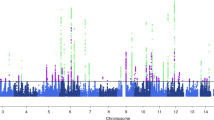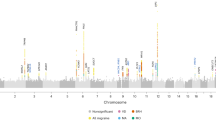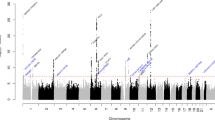Abstract
Migraine is a common, heterogeneous and heritable neurological disorder. Its pathophysiology is incompletely understood, and its genetic influences at the population level are unknown. In a population-based genome-wide analysis including 5,122 migraineurs and 18,108 non-migraineurs, rs2651899 (1p36.32, PRDM16), rs10166942 (2q37.1, TRPM8) and rs11172113 (12q13.3, LRP1) were among the top seven associations (P < 5 × 10−6) with migraine. These SNPs were significant in a meta-analysis among three replication cohorts and met genome-wide significance in a meta-analysis combining the discovery and replication cohorts (rs2651899, odds ratio (OR) = 1.11, P = 3.8 × 10−9; rs10166942, OR = 0.85, P = 5.5 × 10−12; and rs11172113, OR = 0.90, P = 4.3 × 10−9). The associations at rs2651899 and rs10166942 were specific for migraine compared with non-migraine headache. None of the three SNP associations was preferential for migraine with aura or without aura, nor were any associations specific for migraine features. TRPM8 has been the focus of neuropathic pain models, whereas LRP1 modulates neuronal glutamate signaling, plausibly linking both genes to migraine pathophysiology.
This is a preview of subscription content, access via your institution
Access options
Subscribe to this journal
Receive 12 print issues and online access
$209.00 per year
only $17.42 per issue
Buy this article
- Purchase on Springer Link
- Instant access to full article PDF
Prices may be subject to local taxes which are calculated during checkout

Similar content being viewed by others
References
Haut, S.R., Bigal, M.E. & Lipton, R.B. Chronic disorders with episodic manifestations: focus on epilepsy and migraine. Lancet Neurol. 5, 148–157 (2006).
Headache Classification Subcommittee of the International Headache Society. The International Classification of Headache Disorders: 2nd edition. Cephalalgia 24 (Suppl 1), 9–160 (2004).
Mulder, E.J. et al. Genetic and environmental influences on migraine: a twin study across six countries. Twin Res. 6, 422–431 (2003).
de Vries, B., Frants, R.R., Ferrari, M.D. & van den Maagdenberg, A.M. Molecular genetics of migraine. Hum. Genet. 126, 115–132 (2009).
Anttila, V. et al. Genome-wide association study of migraine implicates a common susceptibility variant on 8q22.1. Nat. Genet. 42, 869–873 (2010).
Ridker, P.M. et al. Rationale, design, and methodology of the Women's Genome Health Study: a genome-wide association study of more than 25,000 initially healthy American women. Clin. Chem. 54, 249–255 (2008).
Frazer, K.A. et al. A second generation human haplotype map of over 3.1 million SNPs. Nature 449, 851–861 (2007).
Launer, L.J., Terwindt, G.M. & Ferrari, M.D. The prevalence and characteristics of migraine in a population-based cohort: the GEM study. Neurology 53, 537–542 (1999).
Völzke, H. et al. Cohort profile: the study of health in pomerania. Int. J. Epidemiol. 40, 294–307 (2011).
Proudfoot, C.J. et al. Analgesia mediated by the TRPM8 cold receptor in chronic neuropathic pain. Curr. Biol. 16, 1591–1605 (2006).
Peier, A.M. et al. A TRP channel that senses cold stimuli and menthol. Cell 108, 705–715 (2002).
Dray, A. Neuropathic pain: emerging treatments. Br. J. Anaesth. 101, 48–58 (2008).
Biondi, D.M. Is migraine a neuropathic pain syndrome? Curr. Pain Headache Rep. 10, 167–178 (2006).
Lillis, A.P., Van Duyn, L.B., Murphy-Ullrich, J.E. & Strickland, D.K. LDL receptor-related protein 1: unique tissue-specific functions revealed by selective gene knockout studies. Physiol. Rev. 88, 887–918 (2008).
Andreou, A.P. & Goadsby, P.J. Therapeutic potential of novel glutamate receptor antagonists in migraine. Expert Opin. Investig. Drugs 18, 789–803 (2009).
Secker-Walker, L.M., Mehta, A. & Bain, B. Abnormalities of 3q21 and 3q26 in myeloid malignancy: a United Kingdom Cancer Cytogenetic Group study. Br. J. Haematol. 91, 490–501 (1995).
Seale, P., Kajimura, S. & Spiegelman, B.M. Transcriptional control of brown adipocyte development and physiological function–of mice and men. Genes Dev. 23, 788–797 (2009).
Purcell, S. et al. PLINK: a tool set for whole-genome association and population-based linkage analyses. Am. J. Hum. Genet. 81, 559–575 (2007).
Li, Y., Willer, C., Sanna, S. & Abecasis, G. Genotype imputation. Annu. Rev. Genomics Hum. Genet. 10, 387–406 (2009).
Marchini, J. & Howie, B. Genotype imputation for genome-wide association studies. Nat. Rev. Genet. 11, 499–511 (2010).
Aulchenko, Y.S., Struchalin, M.V. & van Duijn, C.M. ProbABEL package for genome-wide association analysis of imputed data. BMC Bioinformatics 11, 134 (2010).
Hirschhorn, J.N. & Daly, M.J. Genome-wide association studies for common diseases and complex traits. Nat. Rev. Genet. 6, 95–108 (2005).
Mägi, R. & Morris, A.P. GWAMA: software for genome-wide association meta-analysis. BMC Bioinformatics 11, 288 (2010).
Viechtbauer, W. Conducting meta-analyses in R with the metafor package. J. Stat. Softw. 36, 1–48 (2010).
Hindorff, L.A., Junkins, H.A., Hall, P.N., Mehta, J.P. & Manolio, T.A. A catalog of published genome-wide association studies. <http://www.genome.gov/gwastudies/>. (accessed 18 August 2010).
Johnson, A.D. et al. SNAP: a web-based tool for identification and annotation of proxy SNPs using HapMap. Bioinformatics 24, 2938–2939 (2008).
Acknowledgements
This study is supported by a grant from the National Institute of Neurological Disorders and Stroke (NS-061836). The Women's Health Study and the Women's Genome Health Study are supported by grants from the National Heart, Lung, and Blood Institute (HL-043851, HL-080467 and HL-099355) and the National Cancer Institute (CA-47988). Part of the research for this work was supported by grants from the Donald W. Reynolds Foundation and the Leducq Foundation. Genome-wide genotyping and collaborative scientific support was provided by Amgen.
Genotyping in the Genetic Epidemiology of Migraine Study was supported by the Netherlands Organisation for Scientific Research (NWO) VICI (918.56.602) and Spinoza (2009) grants and the Center for Medical Systems Biology (CMSB) established by the Netherlands Genomics Initiative/Netherlands Organisation for Scientific Research (NGI/NWO), project no. 050-060-409. The GEM study was supported by the Ministry of Health, Welfare and Sport and the National Institute of Public Health and the Environment, The Netherlands.
SHIP is part of the Community Medicine Research net of the University of Greifswald, Germany, which is funded by the Federal Ministry of Education and Research (grants no. 01ZZ9603, 01ZZ0103 and 01ZZ0403), the Ministry of Cultural Affairs as well as the Social Ministry of the Federal State of Mecklenburg-West Pomerania. Genome-wide data have been supported by the Federal Ministry of Education and Research (grant no. 03ZIK012) and a joint grant from Siemens Healthcare, Erlangen, Germany and the Federal State of Mecklenburg-West Pomerania. The SHIP authors are grateful to the contribution of A. Teumer, A. Hoffmann and A. Petersmann in generating the SNP data. The University of Greifswald is a member of the 'Center of Knowledge Interchange' program of Siemens AG.
The IHGC study was supported, among others, by the Academy of Finland (200923 to A.P.), the Wellcome Trust (grant number 089062), the European Community's Seventh Framework Programme (FP7/2007-2013) (through the SYNSYS Consortium (grant agreement no. 242167) and the ENGAGE Consortium (grant agreement no. 201413)), the Helsinki University Central Hospital (to M.K.) and the Finnish Culture Foundation (to V.A.). Funding by the German Federal Ministry of Education and Research (BMBF) within the National Genome Research Network (NGFNplus, EMINet-01GS08120 for C.K., 01GS08121 to M. Dichgans), the Deutsche Forschungsgemeinschaft (to C.K.) and the Center for Molecular Medicine Cologne (to C.K.). For a full list of acknowledgements, please see reference 5.
Author information
Authors and Affiliations
Contributions
Obtained funding: J.E.B., M.D.F., W.H., T.K., A.M.J.M.v.d.M., A.P., P.M.R., U.S., H.V., R.Y.L.Z. Overall study design: D.I.C., T.K., M.S. Cohort supervision and phenotyping: V.A., J.E.B., K.F., M.D.F., T.F., W.H., M.K., C.K., T.K., L.J.L., A.P., P.M.R., U.S., M.S., G.M.T., H.V. Analysis and genotyping: V.A., D.I.C., K.F., L.R.G., W.H., A.M.J.M.v.d.M., P.M.R., U.S., M.S., F.E., B.d.V., R.Y.L.Z. Manuscript writing: D.I.C., M.S. All authors participated in critical review of the manuscript for intellectual content.
Corresponding authors
Ethics declarations
Competing interests
The authors declare no competing financial interests.
Supplementary information
Supplementary Text and Figures
Supplementary Note, Supplementary Tables 1–9 and Supplementary Figures 1 and 2. (PDF 192 kb)
Rights and permissions
About this article
Cite this article
Chasman, D., Schürks, M., Anttila, V. et al. Genome-wide association study reveals three susceptibility loci for common migraine in the general population. Nat Genet 43, 695–698 (2011). https://doi.org/10.1038/ng.856
Received:
Accepted:
Published:
Issue Date:
DOI: https://doi.org/10.1038/ng.856
This article is cited by
-
Galcanezumab effects on incidence of headache after occurrence of triggers, premonitory symptoms, and aura in responders, non-responders, super-responders, and super non-responders
The Journal of Headache and Pain (2023)
-
Alterations in DNA methylation associate with reduced migraine and headache days after medication withdrawal treatment in chronic migraine patients: a longitudinal study
Clinical Epigenetics (2023)
-
Genetics of migraine: where are we now?
The Journal of Headache and Pain (2023)
-
A Meta-Analysis of the Genome-Wide Association Studies on Two Genetically Correlated Phenotypes Suggests Four New Risk Loci for Headaches
Phenomics (2023)
-
Current Update on Categorization of Migraine Subtypes on the Basis of Genetic Variation: a Systematic Review
Molecular Neurobiology (2023)



